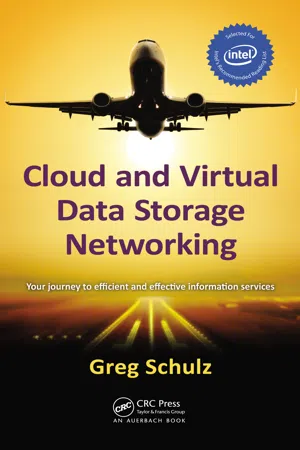Computer Science
Backup
A backup refers to the process of creating a duplicate copy of data to protect against data loss. In computer science, backups are essential for safeguarding important files and ensuring that data can be restored in the event of hardware failure, accidental deletion, or other unforeseen issues. This practice is crucial for maintaining data integrity and continuity of operations.
Written by Perlego with AI-assistance
Related key terms
1 of 5
6 Key excerpts on "Backup"
- No longer available |Learn more
- (Author)
- 2014(Publication Date)
- White Word Publications(Publisher)
________________________ WORLD TECHNOLOGIES ________________________ Chapter 12 Backup In Information Technology, a Backup or the process of backing up refers to making copies of data so that these additional copies may be used to restore the original after a data loss event. The verb form is back up in two words, whereas the noun is Backup (often used like an adjective in compound nouns). Backups have two distinct purposes. The primary purpose is to recover data as a reaction to data loss, be it by data deletion or corrupted data. Data loss is a very common experience of computer users. 67% of internet users have suffered serious data loss. The secondary purpose of Backups is to recover data from a historical period of time within the constraints of a user-defined data retention policy, typically configured within a Backup application for how long copies of data are required. Though Backups popularly represent a simple form of disaster recovery, and should be part of a disaster recovery plan, by themselves, Backups should not alone be considered disaster recovery. Not all Backup systems and/or Backup applications are able to reconstitute a computer system, or in turn other complex configurations such as a computer cluster, active directory servers, or a database server, by restoring only data from a Backup. Since a Backup system contains at least one copy of all data worth saving, the data storage requirements are considerable. Organizing this storage space and managing the Backup process is a complicated undertaking. A data repository model can be used to provide structure to the storage. In the modern era of computing there are many different types of data storage devices that are useful for making Backups. There are also many different ways in which these devices can be arranged to provide geographic redundancy, data security, and portability. Before data is sent to its storage location, it is selected, extracted, and manipulated. - eBook - PDF
- Joseph Steinberg(Author)
- 2019(Publication Date)
- For Dummies(Publisher)
6 Backing Up and Recovery IN THIS PART . . . Find out about the different types of Backups and how to use them. Discover how to prepare a device before restoring from a Backup. Figure out how to restore from a Backup. CHAPTER 13 Backing Up 229 Chapter 13 Backing Up W hile backing up your data sounds like a simple concept — and it is — actually implementing an efficient and effective Backup routine is a bit more complicated. To properly back up, not only do you need to know about your Backup options, but you need to think about many other details, such as the location of your Backups, encryption, passwords, and boot disks. In this chapter, you find out about all those Backup details and more. Backing Up Is a Must In the context of cybersecurity, backing up refers to creating an extra copy, or extra copies, of data (that may consist of data, programs, or other computer files) in case the original is damaged, lost, or destroyed. Backing up is one of the most important defenses against the loss of data, and, eventually, it’s likely to save you from serious aggravation, as nearly everyone, if not everyone, will, at some point, want to access data to which he or she no longer has access. In fact, such scenarios occur on a regular basis. Sometimes, they’re the result of human error, such as a person inadvertently deleting a file or misplacing a com- puter or storage device. Sometimes, they’re the result of a technical failure, such IN THIS CHAPTER » Discovering the importance of backing up » Exploring different types of Backups » Encountering different ways to back up 230 PART 6 Backing Up and Recovery as a hard drive dying or an electronic device falling into water. And sometimes they’re the result of a hostile action, such as a ransomware infection. Sadly, many people believe that they back up all their data only to find out when something goes wrong that they do not have proper Backups. - eBook - PDF
Emergency and Backup Power Sources
Preparing for Blackouts and Brownouts
- Michael Frank Hordeski(Author)
- 2020(Publication Date)
- River Publishers(Publisher)
These disks offer low cost as well as high storage compared to floppy disks. Writable drives (CD-RW) and software are available to write to a CD. Networked PCs can be backed-up using a server with data storage capacity. It may be limited by its own storage capacity or the allocation limitations of the user. When files are saved to the networked disk, the Backup is done through the network or server Backup program. A networked storage device can also be used to Backup local drives on a networked PC. The data are backed-up from either the networked system or the PC. Replication can be used to Backup data for portable and hand-held computers. The portable computer is connected to a desktop PC and the data are copied to the desktop unit. Internet Backup can be used to Backup data over the Internet to a remote location. The confidentiality of the data is not as good, so sensi-tive data should not be backed up this way. The Backup of data is an important part of the contingency plan. But, as the data value diminishes, budgetary realities come into play. A 265 Protecting Computer Data small company with hard copy Backup data might consider a weekly Backup since data lost after midweek can be recreated by staff at less expense that it would cost with redundant systems or more elaborate Backup processes. The sales or payroll database of another small busi-ness may be critical and deserve more expense to keep it protected and available. Incremental Backups can help to reduce losses due to accidental deletion or corruption incidents which may not be immediately detect-able. Miss-edits or inadvertent changes in a value in a database or spreadsheet can require the point-in-time restore found in some Backup and snapshot tools. Process errors such as a failure to Backup data are a problem, since, when combined with other factors, may lead to permanent data loss. The best way to minimize the chance of process failure is automation. - eBook - ePub
CompTIA IT Fundamentals (ITF+) Study Guide
Exam FC0-U61
- Quentin Docter(Author)
- 2018(Publication Date)
- Sybex(Publisher)
Backup policy dictates what information should be backed up and how it should be backed up. If you are concerned only with your own system, you should still create a plan for Backups, including what type you will make and how often you’ll make them. Along with making the Backup, you also need to consider who can get to the Backup. If data is valuable enough to spend the resources required to back it up, it is clearly important enough to protect carefully.When considering a Backup solution, the following questions are pertinent:- How often do you plan to back up? For business-critical data that changes often, every day is appropriate. For casual home users and their personal files, once a week or even once a month may be enough.
- How large are the files? Backing up a large amount of data takes more time and takes up more disk space. You may choose to back up large files like videos and music less often than other files for this reason.
- What Backup software is available? Many different applications will do local and online Backups and system images. Some have more features and higher price tags than others.
- Should each Backup recopy all files, or should there be smaller Backups done that copy only files that have changed?
Understanding the Importance of Backups
Computer users often take their data for granted, forgetting the large quantity of important and irreplaceable documents, images, and music files they collect over the years. A hard disk failure or virus can wipe out years of stored memories, not to mention files of significant value to a business.There are many ways to ensure that a system failure doesn’t result in data loss. For example, you can use a multidisk RAID system to protect against data loss caused by a physical hard disk failure by mirroring a drive (RAID 1) or striping data across multiple drives (RAID 5). RAID isn’t enough, though, because multiple hard disk failures will still doom you. Even if you use RAID, you should perform Backups of your data.The Importance of Data
Several years ago when I did technical support, I received a call from a user with hard drive problems. After some quick troubleshooting, I determined that his hard drive had failed and it would need to be replaced. After telling him the news, he asked, “So how do I get my data back?” I asked if he had backed up his data, and he had not. - eBook - PDF
- Greg Schulz(Author)
- 2011(Publication Date)
- Auerbach Publications(Publisher)
91 Chapter 5 Data Protection: Backup/Restore and Business Continuance/ Disaster Recovery Information security: To protect, preserve, and serve. – Greg Schulz In This Chapter • The difference between business continuance (BC) and disaster recovery (DR) • The importance of an effective data protection plan and strategy • Why it is time to modernize Backup and data protection • How to reduce costs by using tiered data protection and different technologies This chapter looks at issues, challenges, and opportunities for protecting data in cloud, virtual, and data storage networks. The focus of data protection in this chapter is on maintaining availability and accessibility of both active and inactive data. In the con-text of this chapter, data protection builds on the previous chapter’s subject of security by expanding our focus to information accessibility and maintenance of data integrity. Key themes, buzzwords, and trends addressed in this chapter include high availability (HA), Backup and restore, business continuance (BC) and disaster recovery (DR) along with replication and snapshot-related technologies. 92 Cloud and Virtual Data Storage Networking 5.1. Getting Started Mention “DP” to people in IT and, depending on their area of interest and their length of experience, you may get answers such as Dual Platter, Dedupe Performance, Data Processing, Double or Dual Parity, or perhaps even Dance Partner from someone more creatively inclined. For the purposes of this chapter, DP is data protection. “Data loss” can be a misleading idea: If your data is intact but you cannot get to it when needed, is the data really “lost”? There are many types of data loss, including loss of accessibility or availability and complete loss. Loss of data availability means that somewhere—perhaps off-line on a removable disk, optical drive, tape, or at another site on-line, near-line, or off-line—your data is still intact, but you cannot get to it. - eBook - PDF
Practical Industrial Cybersecurity
ICS, Industry 4.0, and IIoT
- Charles J. Brooks, Philip A. Craig, Jr.(Authors)
- 2022(Publication Date)
- Wiley(Publisher)
To protect the organization from these types of occurrences, it may be necessary to specify employing cloud services from multiple ven- dors using multiple cloud service centers. System Backup and Restoration One of the key elements of the BCP is to establish a data Backup and recovery policy to be implemented in the event of a disaster. It is typically the responsibility of the network and/ or server administrators to implement those policies in a Backup and recovery plan that will assure that the network’s operation (and that of the organization) can recover in the case of a disaster. FIGURE 11.6 The architecture of a typical cloud storage solution in a private cloud model System Backup and Restoration 463 Without backed-up data, there can be no contingency plan for an efficient recovery (or possibly any recovery at all). Backup utilities enable the organization to create extended cop- ies of files, groups of files, or entire disk drives for use in the event that a server’s disk drive crashes or its contents become corrupt. Typically, only administrators or specially designated members of Backup Operators groups are given appropriate permissions to back up and restore all data on the server, regardless of their permissions level. However, any user can back up any local files that they have at least the Read permission for. Likewise, they can restore anything they have at least the Write permission for. Users generally have these permissions for their own files, so they can perform Backups and restores of their data as necessary. Administrative responsibilities associated with implementing the Backup recovery portion of the business recovery plan include the following: ■ Establishing types of Backups to be performed: This includes configuring the Backup utilities to conduct normal, differential, incremental, copy, or daily Backup options.
Index pages curate the most relevant extracts from our library of academic textbooks. They’ve been created using an in-house natural language model (NLM), each adding context and meaning to key research topics.





